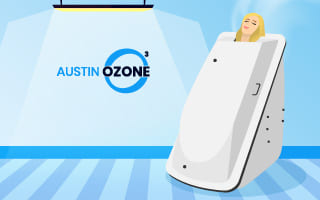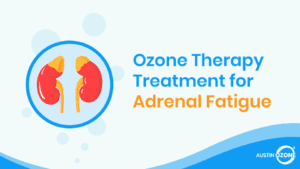Fibromyalgia and chronic fatigue syndrome are lifelong medical conditions with shared symptoms – overwhelming feelings of tiredness or fatigue.
The only difference between the two is that, with fibromyalgia, persistent exhaustion is caused by debilitating pain whereas with chronic fatigue syndrome, it is caused by a significant lack of energy.
Both fibromyalgia and chronic fatigue syndrome are incurable, but that does not mean you cannot control its symptoms. In most cases, a combination of medications, treatment plans, and therapies are needed to manage these conditions.
Unfortunately, most of these common treatment methods are costly and have considerable side-effects. For this reason, people are looking at alternative medicine as a viable option for treatment.
Ozone therapy has been proven beneficial to patients with fibromyalgia and chronic fatigue syndrome.
Schedule an Ozone Therapy Session Today!
Ozone Therapy as a Form of Treatment
This type of therapy introduces ozone gas to the body. Ozone is a colorless gas with three oxygen atoms bound together.
The positive charge of ozone releases an oxidative effect. It can neutralize foreign cells4 such as yeast, viruses, parasites, and bacteria, with a negative charge. Once these cells are neutralized, active infections are killed.
To administer ozone therapy, the gas is introduced to the body with the use of an ozone generator to ensure that the appropriate dosage is administered.
Ozone therapy has been proven beneficial to patients with fibromyalgia and chronic fatigue syndrome.
It has shown a significant contribution in improving the effectiveness of other treatments4 such as chemotherapy and radiation, while boosting the patient’s cellular energy production and oxygen utilization.
The infusion of ozone to the body provides health benefits. It delivers oxygen to our cells and tissues, detoxifies the blood, and increases our energy levels. At the same time, having enough supply of oxygen allows for the development, maintenance, and repair of our cells.
It helps the cells by producing a synthesis of energy that is helpful and needed in carrying out the body’s metabolic and physiologic functions.
At least 20% of our air supply needs to be oxygen in order for the body to achieve wellness; otherwise, health issues like poor concentration, mood swings, sleep apnea, forgetfulness, and tiredness occur. Ozone therapy helps to increase oxygenation of our blood and our bodies’ tissues.
Understanding Fibromyalgia
Fibromyalgia5 is a chronic condition that is manifested by heterogenous symptoms, making it hard to trace and frame from a therapeutic and diagnostic point of view.
The associated symptoms observed in this condition are anxiety, non-restorative sleep, depressive symptoms, and chronic fatigue. Patients with fibromyalgia also experience a cerebral dysfunction called brain fog, which may impair the patient’s concentration and consolidation of short-term memory.
Some of the other symptoms5 that may be associated with fibromyalgia include chronic paresthesia, dermatological disorders, myoclonic twitches, physical fatigue, myofascial pain syndrome, irritable bowel syndrome (IBS), symptomatic hypoglycemia, and headache.
Furthermore, people with fibromyalgia may experience widespread pain, yet it may also be localized in certain parts of the body such as on the neck, shoulders, hips, back, and others. Many patients also report that they experience temporomandibular joint disorder in different degrees.
Treating Fibromyalgia
Ozone therapy helps with the management of fibromyalgia in terms of fighting its symptoms and complications. It neutralizes the toxins and impurities in the patient’s body while improving blood circulation and increasing oxygen levels in the muscles5.
Ozone also decreases the inflammation4 caused by infections and acts as an antioxidant that will energize the patient’s mind and body.
Both fibromyalgia and chronic fatigue syndrome increase the production of pro-inflammatory cytokines2 which lead to sensitivity to pain and mood problems. As such, it potentially weakens the body’s immune system.
In this regard, ozone therapy helps the body by reinforcing the immune system so it can act efficiently in maintaining the body’s wellness. It stimulates the production of non-inflammatory cytokines and reduces the number of pro-inflammatory cytokines to ameliorate infection and inflammation4.
Ozone therapy helps with the management of fibromyalgia in terms of fighting its symptoms and complications. It neutralizes the toxins and impurities in the patient’s body while improving blood circulation and increasing oxygen levels in the muscles.
With the production of non-inflammatory cytokines, the body can fight the infection and inflammation caused by the pro-inflammatory cytokines in a fibromyalgia patient’s body.
Fibromyalgia may also be caused by an abnormal volume of neurons in the brain, making the patient experience pain due to the malfunction of the pain processing pathways.
In this regard, ozone therapy can supply enough oxygen into the body, specifically to the brain, thereby relaxing the brain and regulating it so it can function normally. It can improve the blood oxygen’s saturation and blood circulation in the brain, thus helping it perform well.
In a study conducted by Mohammad Elgawish and colleagues3 where 50 participants underwent ozone therapy either via intramuscular injection or a combination of intramuscular and rectal insufflation, the results showed an improvement in physical symptoms in as fast as 5 weeks of continuous treatment. There was also a significant reduction in visual analogue scale for pain (VAS) by 35.3%.
Understanding Chronic Fatigue
Also called Myalgic Encephalomyelitis (CFS/ME), chronic fatigue syndrome1 is a type of long-term illness that has a wide range of symptoms. The most common of these is extreme tiredness. It can also affect anyone, including younger people. However, it most commonly affects women and develops in the mid-20s and mid-40s.
Symptoms of CFS/ME include extreme tiredness, sleep problems, headaches, flu-like symptoms, sore throat, difficulty in concentrating and thinking, muscle and joint pain, dizziness, and/or irregular heartbeat.
CFS/ME can be triggered when the body has a viral and bacterial infection, weak immune system, hormonal imbalance, and/or mental health problem. It may also be genetically acquired.
While diagnosing CFS/ME can be really difficult, it may exhibit in a patient’s body through autonomic, neuroendocrine, and immune manifestations. It takes two of those three manifestations to be diagnosed with CFS/ME. CFS/ME’s symptoms last for at least six months1.
Autonomic Manifestation
The autonomic nervous system is the one that regulates vital bodily functions like respiration, digestion, urination, and blood circulation, among others. People who suffer from CFS/ME reportedly experience palpitations, low blood pressure, symptoms of irritable bladder, and gastric problems.
Neuroendocrine Manifestation
The neuroendocrine system is composed of special cells that release hormones as a response to a signal received by the nervous system.
An example of this is the pituitary gland, the gland that controls the activities of other hormone-secreting glands. The neuroendocrine abnormalities caused by CFS/ME are mainly manifested in the dysregulation of hormone production (i.e., cortisol, insulin, serotonin).
Immune Manifestation
The immune system is made up of a complex network of proteins and tissues that protect the body from infection by identifying and destroying its source (i.e., microbe). Those diagnosed with CFS/ME have shown some disruptions in their immune cells, making them less effective.
There are at least two additional major manifestations brought about by chronic fatigue, namely cognitive impairment and orthostatic intolerance.
Cognitive impairment1 is when patients have difficulty in thinking, understanding, remembering, and processing information. They may also have defective psychomotor functions. In addition, these will impair the patient’s capability to attend classes or maintain a job.
With orthostatic intolerance1, patients acquire worse symptoms. These symptoms may include abnormalities in blood pressure and heart rate, increased fatigue, worsened cognitive issues, nausea, lightheadedness, fainting, and headache.
This manifestation is considered more bothersome because it occurs during the patient’s day-to-day life. The symptoms may improve, but not fully resolved, by lying down, yet they also worsen when standing upright. It is common among adolescents.
Treating Chronic Fatigue
Ozone therapy can help treat CFS/ME by increasing the body’s energy level. Once the energy level increases, the body can combat and beat the fatigue. In addition, increased oxygen levels in the blood and increased cellular respiration may occur once the fatigue is successfully resolved.
Ozone therapy can also replete nutrients in the body, making it work more efficiently. Through oxidation and the stimulation of cytokines, it can regulate the immune system. The cytokines produced by the ozone gas are used to boost the performance of the body’s immune system in response to pain, inflammation, and infections.
In a study where Umberto Tirelli and colleagues administered ozone therapy on 65 patients with chronic fatigue syndrome, the results showed that ozone therapy is an effective treatment, though they still need to expand the number of subjects for clinical trials to verify their results.
With ozone therapy, the body can respond to viruses, bacteria, and other pains immediately. It also enables the white blood cells to fight viruses more quickly and strongly. Moreover, it may make the symptoms of CFS/ME significantly less painful. Ozone can also improve blood circulation in the legs and reduce the occurrence of fatigue.
In a study where Umberto Tirelli and colleagues6 administered ozone therapy on 65 patients with chronic fatigue syndrome, the results showed that ozone therapy is an effective treatment, though they still need to expand the number of subjects for clinical trials to verify their results.
Conclusion
The benefits of ozone therapy for fibromyalgia and chronic fatigue syndrome are evident in existing trials. The significant reduction in the VAS, coupled by the improvement of physical symptoms, should be enough for patients suffering from either fibromyalgia or chronic fatigue syndrome to try this alternative method.
Many studies aim to gain a deeper understanding not just of ozone therapy’s benefits but also of its main role in helping patients, especially those with chronic diseases.
Standard medications in the treatment of fibromyalgia and chronic fatigue syndrome are seen to be effective. However, they implicate many side effects for the patients.
Since ozone therapy provided notable results in helping in the treatment of fibromyalgia, chronic fatigue syndrome, and other illnesses, it is possible to propose ozone therapy especially to patients of CFS/ME and fibromyalgia who are not getting any sufficient and significant results from other medications and treatments.
Schedule an Appointment Today
References
- Chan, E. (n.d.). Chronic fatigue syndrome treatment — Pangaea clinic of naturopathic medicine Inc. Retrieved from https://www.pannaturopathic.com/chronic-fatigue-treatment
- Dell’Osso, L., Bazzichi, L., Baroni, S., Falaschi, V., Conversano, C., Carmassi, C., & Marazziti, D. (2015). The inflammatory hypothesis of mood spectrum broadened to fibromyalgia and chronic fatigue syndrome. Clinical and Experimental Rheumatology, 33(1 Suppl 88), S109–S116
- Elgawish, M., Ezzeldin, N., Said, D., Mortada, M., & Youseff, A. (2015). OZONE AS AN ADJUVANT THERAPY IN TREATMENT OF FIBROMYALGIA SYNDROME. International Journal of Advanced Research, 3(6), 455-461
- Natural Health Improvement Center. (n.d.). Ozone therapy — Natural health improvement center. Retrieved from https://www.nhicwestmi.com/ozone-therapy
- Pyper, L. (2016, January 11). Fibromyalgia and how ozone therapy can help. Retrieved from https://salvagente.co.za/ozone-saunas/fibromyalgia-and-how-ozone-therapy-can-help/
- Tirelli, U., Cirrito, C., & Pavanello, M. (2018). Ozone therapy is an effective therapy in chronic fatigue syndrome: result of an Italian study in 65 patients. Ozone Therapy, 3(2). https://doi.org/10.4081/ozone.2018.7812
- Tirelli, U., Cirrito, C., & Pavanello, M. (2018). Ozone therapy in 40 patients with fibromyalgia: an effective therapy. Ozone Therapy, 3(3). doi: 10.4081/ozone.2018.7969






